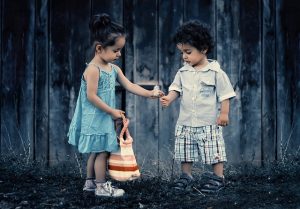Empathy in children. Piaget was not right.


Last modified: 04-12-2023
Are young children capable of empathy? The article describes the study of the 70s., where Helene Borke proves that, yes.
Empathy is a fundamental process underlying the human interaction and communication. It seems as important for interpersonal development as intelligence for cognitive. By observations of spontaneous language of children, their behavior when they play, and coping with cognitive tasks known psychologist and biologist Jean Piaget concluded that social sensitivity, such as cognition, develops in a series of hierarchical stages. According to the theory of Piaget, children between 18 months and 7 years of age are self-centered. According to him they are unconsciously inward looking and are not able to accept someone else’s point of view. Only at the age of 7-12 years child is able to emancipate himself from his point of view and take someone else’s.
Until the study described below, there have not been many studies on the development of empathy, but those that were conducted generally confirmed Piaget’s theory that social sensitivity increases with age. The studies showed that while children grow and gain more experience in interpersonal relations, they begin to have more and more knowledge about thoughts, feelings and motives of other people. According to Helene Borke that does not mean, however, that very young children must be self-centered. Observations of young children suggest that preschool children are not only aware that other children have feelings, but also try to understand them. 2.5 year old child that gives toy to the crying child understands that the child is unhappy. If natural observations indicate that children are aware that others perceive the world differently than they are, Borke wondered why more systematic studies, for example Piaget’s, Burns’s, Cavey’s, Gollin’s and Hardy’s, still showed that young children are egocentric ? A possible explanation is that the tasks were above cognitive ability and experience of young children. In conducting the study tailored to children as young as 3 years, Helene Borke and his colleagues wanted to test the hypothesis that young children are aware of the feelings of others, although they may not have the ability to communicate this awareness.
Empathy in children – Procedure of study
The study involved 200 children from 3 to 8 years. In the first part of the study the children were shown 4 drawings of face: sad, happy, scared and angry, and were asked to identify emotions. If the child has had problems with this, emotions were identified by experimenter. Then he told stories in which the hero experienced one of those emotions. Each story was accompanied by a picture of a blank face and the child had to indicate which fits. In the second part there were presented 8 additional stories, which examined children were described as behaving in some way in relation to another, for example, they were asked to imagine that they give candy, drop another child from a bicycle, or do not allow to play with him. The child was asked to indicate if the child would be happy, sad or angry.
Empathy in children – Results
Children’s ability to correctly identify emotional responses varied significantly with age in 6 of 7 stories in Part I but only 3 of 8 from the second part. Overall social sensitivity increased with age. For history showing fear in first part increase was almost linear. The increase for “happy story” was not as linear. Most children aged 3 – 3.5 years was already aware that the child will be happy at “a happy situation.” Older children responded empathically more ofthen than younger for two “sad stories” in Part I. None of the “sad stories” in the second part showed difference with age. One story of anger in Part I and two in Part II showed an increase with age. There was no difference in the gender.
The age at which children responded empathically to someone’s feelings more often than is by chance differed depending on the emotions that a child identified. 60% of children aged 3 – 3.5 years reported the correct answers to both “success stories” in both parts of the study. It is over 5 times better result than would result by chance. It can therefore be inferred that already 3 year old kids respond empathically when they are asked to identify the happiness more ofthen than it would result by chance. In the group of children 3.5 to 4 years in the Part I 23 of the 25 children correctly identified “happy situation” and in the second part 20 children.
When children were told a story in which a child can react with fear, children between 3 and 3.5 years chose frightened face as often as it would appear by chance. Children between 3.5 and 4 years old chose this face more often than by chance. In the group of 4.5 to 5 years 22 of 25 children responded properly.
In group 3 to 3.5 years old children more often than by chance correctly indicated a sad face. In the group of 5.5 to 6 years 19 of the 25 correctly indicated a sad face in both stories of the parts, but there was no increase with age in Part II.
In the emotion of anger, also at the age of 3 to 3.5 years children more frequently indicated correctly than by chance. In the group of 3.5 to 4 years the incidence was similar to chance. In group 4 to 4.5 years again probability was much greater than the chance. But only 9 of the 25 oldest children correctly identified both “angry stories” in Part I. In the second part there were no increase with age, as in the case of “sad stories”.
Interesting is the difference between the children when they were shown smiling faces and when they were asked to choose one of four face after a happy story. Only 44% of children aged 3 to 3.5 gave a verbal answer spontaneously “happy” and 69% from 3.5 to 4 years. But when they had to choose, 60% and 92% of children indicated that emotion correctly. The first task required a verbal response, and the second despite difficult cognitive, allowed behavioral response. The results support the hypothesis that the type of task used to measure the understanding of emotions by children, significantly affects the ability of children to communicate their awareness of one’s emotions.
Empathy in children – Conclusion
General trend of the growth of social sensitivity with age is consistent with the observations of Piaget and others. Studies indicate, however, that improvement of the ability to respond empathically varies depending on the emotions, that were identified. Awareness of happiness is at the age of 3 to 3.5 years. It seems that first develops children’s ability to distinguish pleasant and unpleasant situation.
Fear was the only emotion that was not recognized correctly in children aged 3 to 3.5 years. At age 3.5 to 4 years it was no longer true. At age 4.5 to 5 years, most children had no difficulty in recognizing situations in which someone was scared. The most obvious explanation is that children under 3 years rarely meet fear than happiness, sadness or anger. Between 3 and 4 years old, children learn to fear through books, television, and its experience. When children become aware of the emotions of fear, no longer have difficulty recognizing it in others.
Empathetic response to the feelings of sadness and anger showed the least steady changes with age. Because sadness and anger may be an appropriate response to the same situation, it is possible that the stories themselves were ambiguous and did not distinguish situations that evoke primarily sadness from those that produce primarily anger. Another possibility is that the results show a stronger conflict associated with feelings of sadness and primarily anger in our society compared with the feelings of happiness and fear. Greater difficulty with sadness and anger in Part II compared to Part I may be the result of a conflict which children experience when they are doing something that may result in another child sadness or anger, because it is socially unacceptable. A third possibility is that the lack of agreement as to whether the situation can trigger sadness or anger reflects individual differences in response to frustration. But no matter what the cause or causes, the results are consistent with observations that empathic responding to sadness or anger is a more complex process than to distinguish between a pleasant or unpleasant feeling or recognize fear in others.
The absence of gender differences in social sensitivity is against our cultural expectations that women have a greater instinct for social and empathic abilities than men. One possible explanation is that the differences between men and women are the result of socialization. In previous years, there were stressed the awareness of women and aggressiveness of men, but later more and more parents began to argue for the possibility that social sensitivity is characterized by both sexes, and no sex by aggressiveness. The discrepancy between the results of testing different researchers may result from the population which came study participants from. If children came from traditional homes, sex differences in social sensitivity appear more likely than if the children come from homes where expectations were the same for boys and girls.
The results of these studies are contrary to Piaget’s theory that children between 2 and 7 years are egocentric. The results suggest that as early as 3 year-old children are aware that other people have feelings and that these feelings are different depending on the situation.
The task used to measure empathy seems to be a key element in determining whether young children will demonstrate empathic abilities. The task in this study was more sensitive than previous ones, because it was in terms of cognitive ability and experience of very young children. Minimized was also a language barrier because children could respond by showing the picture.
References
Borke H. (1971). Interpersonal perception of young children: egocentrism or empathy, Developmental Psychology, 5(2), 263-269.
Author: Maja Kochanowska






Add comment